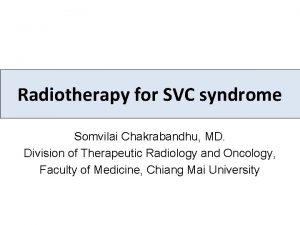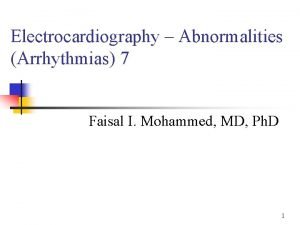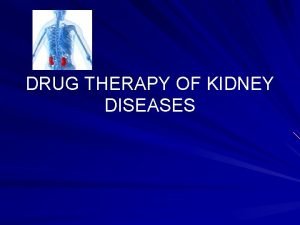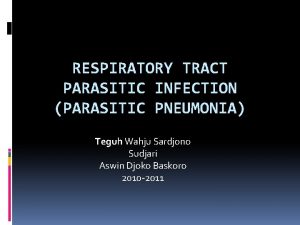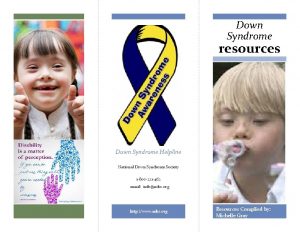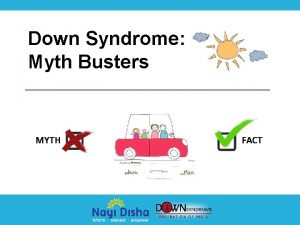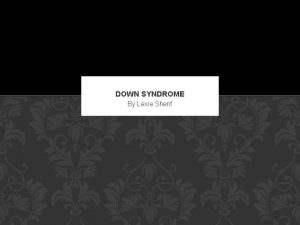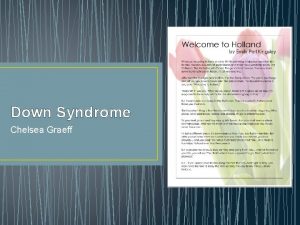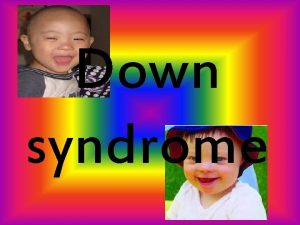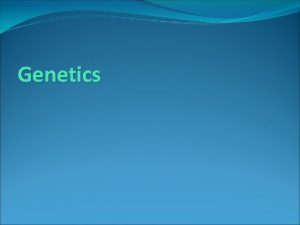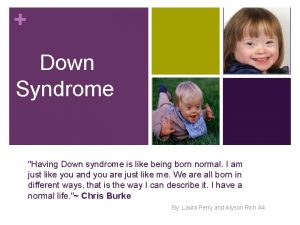DOWN SYNDROME Johanna Martinez What causes Down Syndrome









- Slides: 9

DOWN SYNDROME Johanna Martinez

� What causes Down Syndrome? Down syndrome is a chromosomal condition, and 1 in every 733 babies are born with it. � Trisomy 21 - More than 90 % of Down syndrome cases are caused by. An extra chromosome (chromosome 21) originates in the development of either the sperm or the egg. When the egg and the sperm unite to form the fertilized egg, three (rather than two) chromosomes 21 are present. As the cells divide the extra chromosome is repeated in every cell. � Mosaic Trisomy 21 – This is a rare form (less than 2% of cases) of Down syndrome. While similar to trisomy 21, the difference is that the extra chromosome 21 is present in some, but not all cells. � Translocation Trisomy 21 -Sometimes (in 3 -4% of cases) part of chromosome 21 becomes attached (translocated) to another chromosome (13 th, 14 th or 15 th chromosome) before or at conception. The carrier will have 45 chromosomes instead of 46 but they will have all the genetic material of a person with 46 chromosomes. A carrier will have the extra material but will have only one chromosome 21. The carrier will not exhibit any of the symptoms of Down syndrome because they have the correct amount of genetic material.

�To find out if a baby has Down syndrome before birth, there is one called amniocentesis and the other one is called chorionic villus sampling. They can check the tissue and fluid in the womb for the extra chromosome. After birth, if the baby has any of the physical signs or birth defects of Down syndrome, your doctor can test the baby's blood for the extra chromosome.

Characteristics of Down Syndrome ü A flattened appearance to the face ü A high, broad forehead ü A narrow slit to the eyes ü Pronounced bags or folds under the eyes ü A smaller head, proportionately ü A small, depressed nose ü Small ears ü A large or protruding tongue ü A short neck ü Short arms and legs ü Short fingers and toes ü Large space between the first and second toe ü A single, deep crease in the center of the palm

Myths about Down Syndrome Ø Ø Myth: Most children with Down syndrome are born to older parents. -Truth: Eighty percent of children born with Down syndrome are born to women younger than the age of 35 due to the higher fertility rates. However, research has shown that incidence of births of children with Down syndrome increases with the age of the mom. Myth: The life expectancy of people with Down syndrome is 30 years. -Truth: They do increased risk for certain medical conditions such congenital heart defects, respiratory and hearing problems, Alzheimer's disease, childhood leukemia, and thyroid conditions. Many of these conditions are now treatable, so most people with Down syndrome lead healthy lives. As many as 80 percent of adults with Down syndrome reach age 55, and many live longer. Myth: Adults with Down syndrome cannot form interpersonal relationships, marry or have children. -Truth: People with Down syndrome date and marry and it is possible for women with Down syndrome to have children. There is a 50 percent chance that the child will have Down syndrome. While extremely rare, men with Down syndrome can father children. Myth: People with Down syndrome are severely “retarded. ” -Truth: Most people with Down syndrome have IQs that fall in the mild to moderate range of intellectual disability but they can fully participate in

EARLY INTERVENTION It is a therapy program designed to address developmental delays that may be experienced by children with Down syndrome or other disabilities. It includes giving them physical therapy, speech and language therapy, and occupational therapy. These services are mandated by a federal law called the Individuals with Disabilities Education Act (IDEA). The law requires that states provide early intervention services for all children who qualify. Its goal is to enhance the development of infants and toddlers and help families understand meet the needs of their children.

Education There is a growing number of schools in the United States where children with Down Syndrome and other disabilities Can learn along with children that don’t have disabilities, this is called Inclusive Education. Inclusion is a philosophy of education based on the belief in every person’s inherent right to fully participate in society. Students who have special needs as well As those who don’t, benefit from this

Tips for teaching children with Down Syndrome 1. 2. 3. 4. 5. 6. Have high expectations and encourage them When planning a student's instructional program, be guided by the student's individual ability and needs, and not the label of Down syndrome. Small group instruction may be more beneficial to the student than whole class instruction. If the student makes a mistake, do not say "that's wrong. " Ask the student to try again, or provide the correct response and require the student to repeat the correct response immediately. Present only a few stimuli or objects at a time. For example, if you are using worksheets, create worksheets that do not have too many pictures or sentences with complicated wording. Highlight or print key words in bold. Be flexible with attaining educational goals. For example, if the student has difficulty writing with a pencil, teach the student to write using a computer

More alike than different Although people with Down Syndrome often have mild to moderate delays their cognitive and physical development, like all people they develop at their own rate and in their own way. They have many different goals for their futures and expectations of their roles in the family, school and community. Down syndrome doesn’t determine how capable Someone is in life. .


